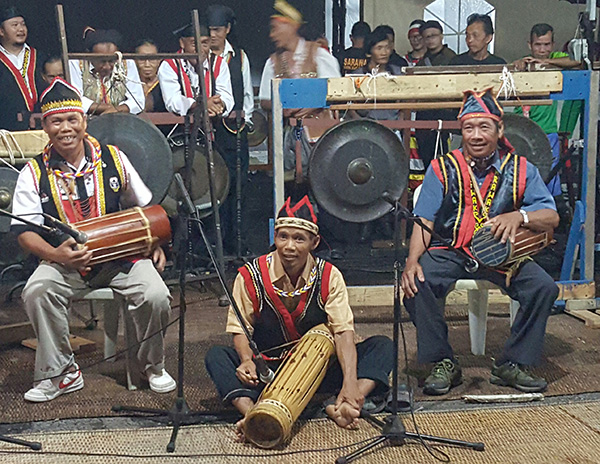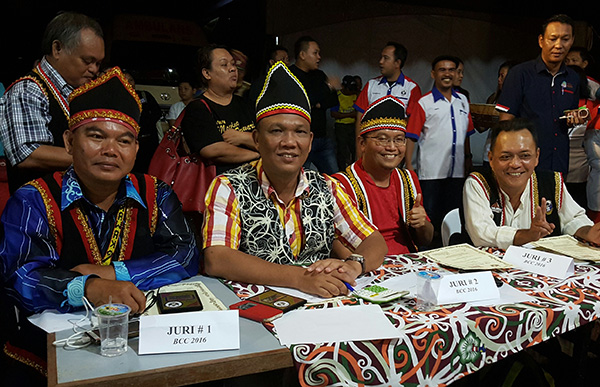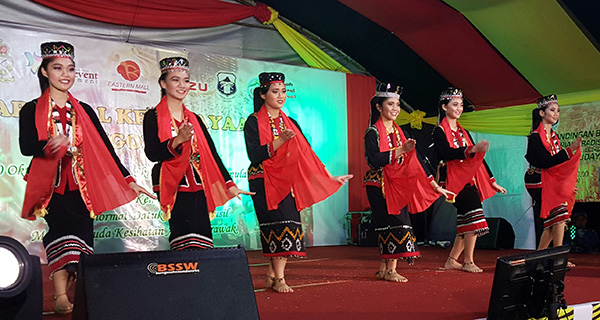
The Rabak Kham Cultural Club performers with the rhatong player in the middle.
IT was drizzling at Bengoh Resettlement Scheme (BRS) but that did not dampen the spirit of about 2,000 people who turned up to watch the Bidayuh Bergong and Traditional Dance competition.
The competition was the curtain raiser of the Bengoh Cultural Carnival (BCC) which has breathed new life into BRS.
With the sounds of traditional gongs, dating back 3,500 years, and other musical instruments, made of bamboo and animal skins, filling the evening air, cultural groups performed choreographed dances rich in Bidayuh lore.
According to the organisers, the Dance competition sought to improve the preservation of Bidayuh cultural heritage, at the same time, raising awareness among Bidayuh youths of their ancestral cultural practice going back hundreds of years.
It was truly a celebration of ‘live’ performances steeped in Bidayuh tradition and culture.
Visitors attending the competition at BRS, about 40km from Kuching, were treated to the rarely heard beats and rhythms of ‘live’ Bidayuh traditional music and dance.
The evening offered a Bidayuh cultural experience like no other.
Permanent Secretary to the Tourism, Arts and Culture Ministry Datu Ik Pahon Joyik commended the event, saying: “This type of event can help improve the preservation of Bidayuh cultural heritage and raise awareness among Bidayuh youths of their ancestral culture.
“While many of our young people no longer know our traditional culture, I want this event to be promoted and sustained as part of our education, rooting our youths to our culture,” he added.
Every team seemed well prepared for the competition, looking very organised in presenting their music or dance.
I enjoyed the nearly three hours I spent there.
Informative synopsis
The event was also quite informative as some of the teams provided their synopsis which could even be kept for documentation.
For example, the Rabak Kham Cultural Club gave details on their traditional instruments which most Bidayuhs might never have heard of or seen before.
The Club, managed by Denson Dorong from Kampung Kemas in Ulu Padawan, did not win any prize but their beautiful mix of music from the rhatong and drums or gendang as well as their legendary dance had not only awed many in the audience but also offered an experience of a life time.
Instead of using gongs, the team introduced their traditional instrument — rhatong — which, according to their synopsis, is a traditional musical instrument of Bidayuh Biatah Biya from Ulu Padawan.
It is made of a type of bamboo called patung in Bidayuh Biatah Biya dialect.
A rhatong represents nine types of gongs of different sounds. The strings are made of bamboo blades.
The biggest bark or string is called the number one tone. The numbers go up to nine, depending on the size of the bark.
Each bark produces a different tone or sound whose code number is selected and tuned in a clockwise direction.
The numbers for the tonal codes are as follows: No.1 for tawak, No. 2 for tong, Nos. 3 and 4 for peei 1 and peei 2, No. 5 (sanang ngang), No. 6 (sanang ngeng), No. 7 (sanang ketet), No. 8 (puui 1) and No. 9 (puui 2).
Unlike a set of gongs which require many players, the rahtong requires only one.
Rhatong music is normally accompanied by two drums or gadok. One drum is called nganak and the othern ngindu, in Bidayuh Biatah Biya.
On the competition evening, the Rabak Kham Cultural Club presented a beautiful combination of three traditional musical instruments to accompany the dance called Rajang Rami.
The music and dance were authentic although not good enough to win any prizes. Maybe they had not fully met the competition requirements where the gong is the main instrument to be used.
Head of jury Cottrell Tassim said all the teams had put up outstanding performances for a very close contest.
“The teams brought together almost all aspects of their culture, especially in the music and dance. I’m impressed with some of the choreography and creativity. Overall, it was a good show,” he enthused.

Head of jury Cottrell (right) and his fellow jurors.
Victorious SMK Siburan
The contest attracted 14 teams from Puncak Borneo, Padawan, Siburan, Bau and secondary schools from the surrounding areas.
Creative Art Club from SMK Siburan emerged champion, impressing judges with their sigar pinyambut dance to take home RM1,000 and certificates.
The team, comprising six women and four men dancers, gong and drum players, showed via their dance, how the Bidayuhs in Bau welcome guests to their Baruk or headhouse where Bidayuh warriors used to congregate.
One of the original Baruks still exist in Kampung Opar, Bau, but in these modern times, the architecture is contemporary like that of Mutiara Tebedu and the Bau Civic Centre, to name a couple.
Bung Siburan heritage cultural troupe finished runner-up while Kumpulan Traditional Kampung Semadang took third spot.
Gaza-Kampung Giam Asar and Anak Seni Kenyalang placed fourth and fifth respectively.
Except for Rabak Kham Cultural Club which danced to the tempo of rhatong and drums, all the teams danced to the beats of gong ensembles.
From the competition, it was obvious Bidayuh traditional dances and rhythms of gong music vary from region to region although most dances share certain characteristics.
The Bidayuhs are known for having a gong-ensemble-centric musical heritage. The gongs are suspended or held while being played. The bossed or knobbed gongs act as drones without any accompanying melodic instruments.
Ritual dances
In Bidayuh tradition, there are several ritual dances supposedly meant to bring good fortunes to members of the community.
In ancients times, the Bidayuhs believed both good and bad spirits inhibited the world. The latter were said to cause disasters and hardships if disturbed.
To communicate with the spirits, a ritual dance was performed to ensure the community’s continued safety.
There are several types of Bidayuh ritual dances, one being tolak bala or danger-repealing.
This dance is believed normally performed before the harvest to ask for blessings and protection of the community.
The tolak bala was among the dances performed by some of
the teams in the Bidayuh Bergong and Traditional Dance competition.
Other ritual dances include langi julang, nguguoh or simutur and rejang padi or ngirindang.
The ngirindang or sambut padi bauh was performed the most in the competition.
There are also Bidayuh dances for entertainment such as the eagle-warrior fight dance, traditionally performed after the harvest.
Hands are held outstretched, imitating the movements of the eagle as it flaps its wings in flight. The eagle eventually falls unconscious, leaving the warrior as the winner. It’s performed by men seeking female partners.
This dance, however, was not performed in the competition.
Actually, one could tell the origins of the teams by the gong music they played.

The Creative Art Club of SMK Siburan performing the Sigar Pinyambut dance.
